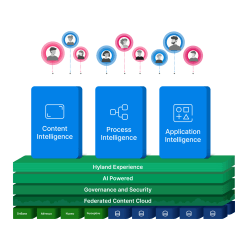4. Useful information management
Effective ECM solutions ensure that the right information reaches the right person, in the right context, at the right time. By centralizing documents and making them easily searchable, ECM systems simplify access to the information employees need for quick and accurate data-driven decision-making.
Employees depend on fast, straightforward methods to find the information necessary to analyze situations and make decisions. Ubiquitous access, efficient search tools and single source to search are all critical when conducting research to make business decisions. Unfortunately, few legacy solutions address these important requirements.
Unlike legacy systems that required everything to be stored within the system’s repository, best-in-class ECM solutions expand their content management services to include other repositories within the enterprise.
These include file shares, content repositories from other ECM systems and content stored within other business systems such as enterprise resource planning (ERP), customer relationship management (CRM) and human resources (HR) systems. By federating results across the enterprise, no major data migration is required to create a single source of the truth.
By seamlessly integrating enterprise repositories, best-in-class systems simplify search and accelerate access to critical information. This virtual “single source of the truth,” allows customers and employees to use one search tool to find information that may be scattered across the enterprise.
















